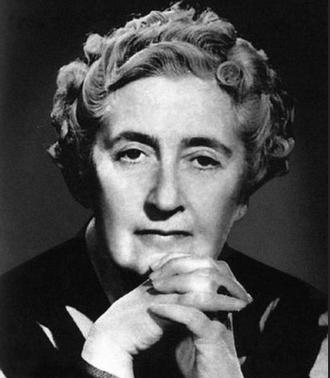By the mid-1950s, Agatha Christie had already cemented her status as a literary titan. With iconic characters like Hercule Poirot and Miss Marple under her belt, she constantly pushed the boundaries of her storytelling. It was during this period that Christie’s imagination birthed a tale that would blend the serenity of an English girls’ school with the thrill of international espionage. This was the inception of Cat Among the Pigeons, which was later published in 1959.
Agatha Christie’s Cat Among the Pigeons is a unique blend of murder, mystery, and international intrigue, all set against the backdrop of a prestigious English girls’ school. This intriguing mix of elements is what sets this novel apart and makes it an interesting installment in the Christie pantheon.

Plot Summary
The novel begins in the fictional Middle Eastern country of Ramat, where political unrest culminates in a revolution. In anticipating his imminent overthrow, Prince Ali Yusuf entrusts his invaluable jewels to his loyal friend, pilot Bob Rawlinson. Rawlinson hides the treasures in the luggage of his sister, Joan Sutcliffe, who is returning to England with her daughter, Jennifer. Unbeknownst to them, the jewels are now on their way to Meadowbank, an exclusive girls-only school.
As the new summer term begins at Meadowbank School for Girls, the atmosphere of academic excellence and genteel tradition is shattered by the murder of Miss Springer, the school’s athletic instructor. She is found shot in the sports pavilion, a crime that sends shockwaves through the school community.
The police investigation yields few leads, and fear and suspicion permeate the school. The headmistress, Miss Bulstrode, struggles to maintain order while dealing with her desire to name a successor when she retires from teaching. Miss Bulstrode is flanked by her devoted lutescent Miss Chadwick, her natural successor Miss Van Stittart, who is much like Miss Bulstrode in temperament and ideals, and the newly appointed Miss Rich, who loves teaching but has new directions for the school.
Miss Bulstrode’s musings and probing questions mean we get lots of on-one time with the staff of Meadowbank, from the bored new French mistress to the lowly new Gardner, who is a plant for the British government who is trying to ascertain if Jennifer Sutcliffe unwittingly has brought to jewels to school.
The school girls, from the unimaginative Jennifer Sutcliffe to her best pal, the clever and resourceful Julia Upjohn, to the beautiful and mature Princess Shiaista, cousin to the deposed Prince Ali, make up the coterie of young characters who enrich and provide fun in the deftly written portrayal of Meadowbank, their happy, unremarkable lives in great contrast to the jockeying politics of the staff, and the greater political reconfiguration.
Jennifer Sutcliffe becomes a pivotal character as it is revealed that she unknowingly possesses the hidden jewels. Meanwhile, the French teacher, Mademoiselle Blanche, and various students exhibit suspicious behavior, adding complexity to the unfolding mystery. A second murder, that of Miss Vansittart, heightens the tension and urgency to uncover the truth.
However, Julia Upjohn’s cleverness figures out where the jewels Bob Rawlinson hid and smuggled out of Ramat are shown. Once she finds the stones, she realizes that the murders at Meadowbank are part of something much bigger and more sinister than anyone realizes and calls on Hercule Poirot, who had met her aunt on a previous case.
Hercule Poirot embarks for Meadowbank and quickly reveals that international intrigue and petty school politics have led to murder. He finds the cat hiding among the pigeons through interviews and keen observation.
Poirot’s inquiries lead him to several key revelations. He discovers that Miss Springer had been snooping around the sports pavilion and had come across something she wasn’t supposed to see, leading to her murder. He also uncovers the link between the jewels and the murders, identifying those who would benefit from their recovery. In a stunning denouncement Poirot reveals all of the secrets and plots festering under Meadowbank’s stolid veneer.
The Review
Cat Among the Pigeons has a lengthy prologue where the reader follows the actions of Bob Rawlinson on the eve of a political revolt and coup. Surprisingly, Rawlinson dies while flying out of the country, and he’s not the story’s protagonist. Instead, the book takes us on a meandering journey- the same journey as the jewels- to a house in England owned by the harried Joan Rawlinson, who is more irked at the idea of unpacking her things and setting up a house than she is by her brother’s death. An agent of the British secret service attempts to glean any information from Joan about the jewels, but she isn’t the least bit intrigued by their disappearance.
However, British intelligence and agents of foreign powers are unsure and have set up operations to follow her and her daughter, Jennifer. Jennifer, bound for Meadowbank School, is shadowed by the British government in the form of a chatty and amorous gardner, who has the advantage of being the only man under sixty on the whole campus. The book again makes the strange decision not to make Jennifer the protagonist- probably because she’s dreadfully boring or the secret service agent- instead opting to make the school’s headmistress the vessel through which we roam the school and gain information.
This is a strange choice, Miss Bulstrode is preoccupied with her success to such a degree that she fails to notice anything roiling international or not- and even fails to notice when Julia Upjohn leaves surreptitiously leaves the school to hire Hercule Poirot, who then becomes the protagonist after 60 percent of the book has taken place- which is a real shame because Julia Upjohn is a fantastic little girl with some serious grit who is dropped once Poirot swans into Meadowbrook. The somewhat scattershot leaping from protagonist to protagonist could have been easily avoided if Cat Among the Pigeons was not a Hercule Poirot detective story but a Tommy and Tuppence thriller.
Here me out: wouldn’t the book make more sense if after the coup in Ramat British intelligence hired two of their best agents at tracking down foreign goods and stopping rogue foreign agents: Tommy and Tuppence. Tuppence to be a new school mistress at Meadowbank and Tommy to be the new gardner. Tuppence could snoop on her fellow teachers and gain the trust of pupils such as Julia Upjohn who could still recover the jewels. Tommy could listen to gossip and could tackle to enemy agents trying to infiltrate the school and kidnap Princess Shiaista. A lot of the original beats of Cat Among the Pigeons would still remain, and the story would flow seamlessly.
I know Hercule Poirot was brought into the story because he is her most famous creation, but Poirot doesn’t work well in these international intrigue plots. We don’t want an armchair detective coming in the last bit of the book and telling us the solution- we want somebody to be in the thick of the fight- spying, getting coshed on the head, escaping peril and then revealing the enemy agent. Casting Poirot as the hero is a misstep, that takes what could have been a great book and demotes it to merely middling.
The fall of Ramat is one of Christie’s better entrances into the world of political intrigue- it was timely when she was writing it and is perennial, governments fall, often violently and the ripple affects of that are far reaching and often unexpected. Having the flashpoint of the aftermath in a girl’s school is an entertaining twist.
Meadowbank is a great setting, filled with well drawn and dulpcilitous teachers and equally well drawn girls, heady with freedom, petty jealosuisies and problems. The school and it’s inhabitants are a rich and vibrant part of the story, that I think the reader could have really steeped in, if Christie had figured a better way to make the trouble in Ramat roost in the school. Miss Bulstrode is a great character and I enjoyed her immensely, but she doesn’t bridge the gap between what happened in Ramat and what is happening at the school and she never does.
I loved the little snippets of the girls obsession with tennis, boys, and gossiping about their teachers between themselves and in letters home. I think that was a really ingenious way to bring the POV into the story and fleshing out their characters. I think it would have been funny to see Tuppence try to teach and I bet the student gossip would have really been rampant and hilarious. Watching Tuppence snoop and spy on her fellow teachers also would have lead to some great moments given how ready she is with a complicated and hearty backstory and identity. I wonder what ridiculous name she would have given herself.
Hercule Poirot cannot enter the world of a girls school like Meadowbank and he’s hamstrung from the beginning and leaving his deductions in the final third of the book unsupported and a little silly feeling. He never settles into the story because he isn’t in the story, but rather a vehicle for the story to be solved. The thing is though, with these thriller elements, the story is cut off at the knees if it’s just reduced to a puzzle. I get, that with Poirot no other solution is possible- he is not a man who is going to fly all over the world making inquiries and what inquiries are there to be made- Rawlinson is dead, so is Prince Ali Yusef. Poirot, not being in Ramat- again another way to circumvent the structural problems a bit better is left to do very little- untangle the motives for the murder, which if Julia Upjohn had been given enough resources I think she could have peaced together, since she managed to find the jewels before Poirot even knew that there was a school called Meadowbank.
Cat Among the Pigeons has a the bones of a good story that never really became the sum of it’s parts due chiefly to using Hercule Poirot. He’s the element that usually raises the caliber of the story but in this case he breaks the story. A detective story is not a thriller and these two lanes of mystery fiction were clearly delineated since the 1930’s. There are of course some writers who can successfully mix elements of both- but not Chrisite- see The Big Four as another thriller attempting to be a detective story that is regarded as a bit of a flop.
Cat Among the Pigeons is certainly better than The Big Four, the characters and rich setting really buoy up Cat Among the Pigeons, I just wish that it all came together in the end to be a great story, it could have but just doesn’t, which is a shame.

Agatha Christie Biography
Agatha Christie, born on September 15, 1890, in Torquay, England, was a renowned British author best known for her detective novels and short stories. Often called the “Queen of Mystery,” Christie created iconic characters such as Hercule Poirot and Miss Marple, who have captivated readers worldwide. Her literary career began in 1920 with the publication of “The Mysterious Affair at Styles,” introducing Poirot. Christie’s works are characterized by intricate plots and clever twists, with “Murder on the Orient Express” and “The Murder of Roger Ackroyd” among her most celebrated. Over her lifetime, she wrote 66 detective novels, 14 short story collections, and the world’s longest-running play, “The Mousetrap.” Christie’s influence on the mystery genre remains unparalleled, and her books have sold over two billion copies, translated into numerous languages. She was made a Dame Commander of the Order of the British Empire in 1971. Agatha Christie passed away on January 12, 1976, leaving behind a legacy that continues to intrigue and entertain readers around the globe.




Leave a comment